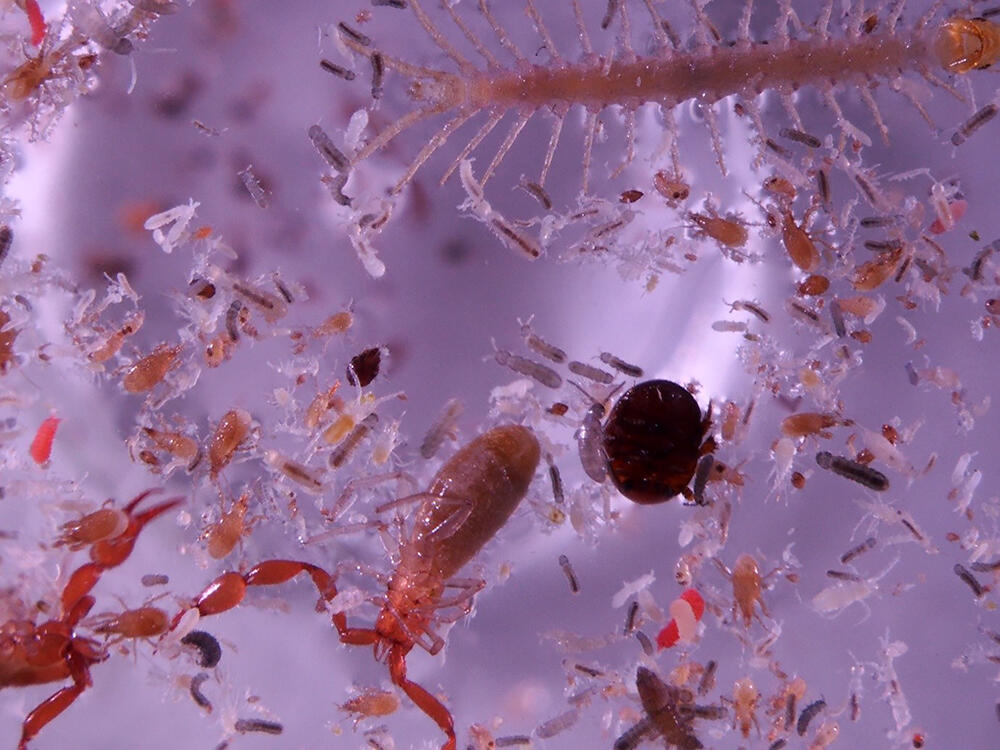Material such as the leaves produced by plants via photosynthesis wither and fall to the ground and are then decomposed by the activity of soil microorganisms and fauna. This has been a commonly held belief for a relatively long period of time. However, in reality, it has been difficult to identify the food sources of the tiny organisms that live in the soil. Due to this, it was unclear whether they actually fill the role of decomposers.

(Provided by Forestry and Forest Products Research Institute)
A research group consisting of individuals from the Forestry and Forest Products Research Institute, the Research Institute for Humanity and Nature, and the Research Institute of Environment, Agriculture and Fisheries, Osaka Prefecture has revealed that many groups of soil fauna such as Collembola (springtails), which dominate in terrestrial ecosystems such as forests, do not function as decomposers of dead organic matter such as fallen leaves. In recent years, it has been suggested that Collembola depend not only on food derived from dead matter but also on living food sources such as algae and plant roots. If Collembola's dependence on dead and decomposing matter is low, it may also impact the diets of various soil fauna, including spiders and other collembolan predators. However, to date, no definitive evidence had been obtained as to which food source the omnivorous springtail is majorly dependent on.
To investigate further, the research group evaluated the degree of dependence of soil fauna on dead organic matter, mainly focusing on collembolans, via carbon dating of their prey for the very first time. The research group targeted various soil fauna classification groups centered on several collembolans inhabiting the natural cypress forest of the Kamigamo Experimental Station, Field Science Education and Research Center, Kyoto University. Radiocarbon isotope (14C) analysis and carbon / nitrogen stable isotope (13C/15N) analysis, which have been conventionally used for food habit analysis of soil animals, were conducted on these groups.
The results indicated that most species of Collembola showed a lower Δ14C* concentration than that of dead organic matter, regardless of the carbon / nitrogen stable isotope ratio. This indicates that collembolans feed on newer carbon that has recently been photosynthesized rather than on the carbon in dead organic matter, regardless of prey type. On top of this, soil fauna living in humus layers deeper than the surface layer (layer consisting of newly fallen leaves) showed a tendency to be more dependent on new carbon as the nitrogen stable isotope ratio increased.
To date, it was not possible to determine whether the reason for the high nitrogen stable isotope ratio was that springtails fed on organic matter that had been decomposed by microorganisms or that they fed on mycorrhizal fungi. However, based on the results of the 14C analysis, it was inferred that the reason was the latter. The results provided robust evidence that the dependence of collembolans on dead organic matter was marginal. Predators such as spiders and centipedes generally showed older carbon ages than collembolans, but often had younger carbon than that from dead organic matter, and the dietary habits of collembolans strongly affected the entire soil food web.
It has been shown that many taxa of soil fauna, which have been generally defined as decomposers (including predators such as collembolans, beetles, centipedes, and spiders), are rather positioned as consumers in the food web. It has been pointed out that it is necessary to preserve biodiversity and its functions before the disappearance of living organisms due to environmental changes. However, our results also point to the danger of judging the function of organisms on ecosystems without sufficient evidence.
■ Δ14C: The 14C isotopic ratio of a material relative to the modern standard after correction for changes due to reactions.
This article has been translated by JST with permission from The Science News Ltd.(https://sci-news.co.jp/). Unauthorized reproduction of the article and photographs is prohibited.




